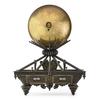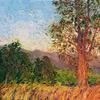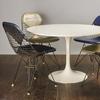First Museum Survey of Sculptor Arlene Shechet Opens June 10 at the Institute of Contemporary Art/Boston
- BOSTON, Massachusetts
- /
- March 23, 2015
The first museum survey of sculptor Arlene Shechet, this major exhibition features over 150 objects that, seen together, trace the development of Shechet’s innovative practice over the past 20 years. For her entire career, the artist has embraced an experimental approach to sculpture, finding form in the chance processes that occur as mutable materials—such as plaster, ceramic, paper pulp, and glass—become solid. Shechet has, over the last decade, generated a body of work remarkable for its use of clay. Her exhilarating, polymorphic sculptures test the limits of form, and deploy color to generate painterly effects and visceral surfaces. Fascinated by clay’s material history, she recently completed a residency at the renowned Meissen Porcelain Manufactory in Germany. The resulting body of work—including mashups of functional objects and whimsical figurines—show an artist at the top of her form: recasting centuries-old traditions into her own mold. On view from June 10 through Sept. 7, Arlene Shechet: All at Once is organized by Jenelle Porter, Mannion Family Senior Curator.
“Arlene Shechet’s work over the past two decades has brilliantly and beautifully challenged conventions in ceramics, drawing, painting, and sculpture,” said Jill Medvedow, Ellen Matilda Poss Director of the Institute of Contemporary Art/Boston. “Arlene Shechet: All At Once takes audiences on a journey of exploration and imagination, asking essential questions about the physical world and presenting an artistic vision that transcends it.”
“Shechet has made a major contribution to the contemporary conversation about process and material,” said Porter. “Now several years into a commitment to sculpture in ceramic, Shechet pushes the boundaries of her medium to reveal endless possibilities of form and surface. For her, clay is the material that allows for the most unmediated experience with art; it’s a living material, one capable of recording and externalizing the emotional and physical process of its making."
The exhibition is organized chronologically to demonstrate how the artist has moved fluidly from one material to the next. The introductory gallery contains works from the 1990s: plaster Buddhas and Buddha heads, a series of works on paper focused on stupa floorplans, and cast paper vessels. The latter, from a larger installation titled Once Removed (1998), references blue-and-white porcelain and Shechet’s ongoing consideration of the histories and traditions of West and East. Her work in paper from this decade inaugurated a continued exploration of the capabilities of material—which Shechet constantly pushes upon—as well as her own skill. The Buddhas, heads, and cast paper vessels are displayed on an artist-designed and composed multilevel plinth. The first room of the exhibition introduces viewers not only to Shechet’s art, but her particular form of installation. The artist has designed the entire exhibition, carefully composing and choreographing the viewer’s experience of her work.
The second room features two bodies of work: Building (2003) and In the Balance (2004). Building, a cityscape-like installation of cast porcelain vessels that shade from white to black, introduces viewers to casting, one of the most ancient of sculpture’s modes. Its stacked forms recall stupa architecture as does In the Balance, a series of mouthblown crystal shapes.
In the 2000s, Shechet’s work in glass led to experimentation with clay, which allowed her to work immediately and independently. For an artist long involved with drawing, she found clay to be a “three-dimensional drawing material” as well as a material with a captivating history.“ Shechet’s first body of sculpture was about breath (coming on the heels of her blown crystal), and resembles smoke puffs, clouds, lungs, oil lamps, and other air-filled forms. To counter this bulbous airiness, Shechet finished the forms with heavy monochromatic and metallic glazes. Enlivening the sculptural dialogue about object and base stimulated by the work of modernist artists such as Brancusi, Shechet made the clay sculpture to sit atop composed bases of plaster, wood, metal, and other materials.
The third room of the exhibition—a long gallery extending the entire length of the ICA’s West Gallery—displays 25 ceramic sculptures that highlight the ways Shechet has explored form, display, color, weight, and balance. In 2009, she returned to high-key color, treating the surfaces of the clay as supports (like a canvas) for gestural color.
Shechet’s most recent work fills two final rooms adjacent to the ceramic sculpture gallery. The first contains a series of cast paper works that show her mastery of color as applied in paper, unusually, to molds made from materials Shechet uses in her studio: kiln bricks, tabletop leftovers, chunks of clay. The second of these rooms is an elaborate, specially-designed, intimate room that features work from the artist’s 2012-2013 residency at the Meissen Porcelain Manufactory in Germany. For the ICA exhibition, Shechet is creating a mise-en-scene that will incorporate more than 55 pieces of her own work alongside historic 18th-century Meissen figurines and wares.
About the artist
Arlene Shechet has received broad recognition for her corporeal and suggestive ceramic work. She is the recipient of numerous awards including a 2004 John S. Guggenheim Foundation Fellowship Award, New York Foundation for the Arts awards, a 2010 Anonymous Was a Woman Artist Award, a 2010 Joan Mitchell Foundation Painters and Sculptors Grant, and a 2011 American Arts and Letters Award for Art. Her work is included in both public and private collections worldwide including the Brooklyn Museum of Art, Los Angeles County Museum of Art, Princeton Art Museum, Whitney Museum of American Art, Walker Art Center and the Nerman Museum of Contemporary Art. Shechet holds a B.A. from New York University and an M.F.A. from the Rhode Island School of Design. She lives and works in New York City and upstate New York.

100x100_n.jpg)
100x100_c.jpg)













100x100_c.jpg)